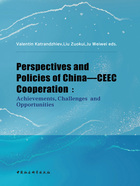
I.Contextualising the Framework: China, CEE and the “West”
One of the defining characteristics of the Framework is the importance and role of external context and actors. For one, the parameters of the relationship between China and CEECs are to a substantial extent shaped externally. Moreover, the implications of the Framework go well beyond the context of China-CEE relations alone.
Given the design of the Framework, the BRI, and the role that CEE countries play within the two initiatives, there is an important regional and global aspect to China-CEE relations. The Framework does not serve only as a platform to advance relations between China and CEE countries, but has been conceived from the beginning as a platform to contribute to China-EU relations and facilitate economic ties between all of Europe and China. Within the framework of the BRI, CEE is also meant to contribute to China’s broader regional and global policies and objectives and serve as an important component in the plans to promote trade and investment between China and the rest of Eurasia, including, importantly, the EU (Liu, 2017).
Moreover, the EU regards all of CEE—regardless of the membership status of individual CEE countries—as its own “backyard” (Vangeli, 2019). This implies the power relations within which the CEE countries which are the EU member states are expected to formulate their foreign policies with consideration for the preferences in Brussels and major European capitals. As the five non-EU members from the Western Balkans are expected to eventually accede to the European Union, a high degree of synchronization of their policies with those of the EU’s is also expected, as reflected in an EU-centric engagement framework whose aim is to promote reform and development in WB that will ensure compliance and alignment with the EU’s normative, regulative and policy frameworks (Pavlićević, 2019). In such a context, CEE countries’ relations with China are not regarded by the EU as separate from the EU’s relationship with China. The EU thus expects that the CEE approach to China will not diverge from an EU-wide approach as articulated in Brussels and the leading EU member states.
This context therefore establishes the EU-and those EU members with more decision-making power and leadership positions within the bloc-as a key stakeholder in China-CEE relations and provides them with the means to decisively shape the trajectory of the China-CEE relations. Overall, the EU membership—current or prospective—of the European countries participating in the Framework, as well as the political, economic, and normative integration of CEE with the EU (including the dependence of former on the latter, and the power relations that result from there), configure China-CEE relations as a triangular relationship, with the EU being the third point of this triangle.
Additionally, membership of most of the CEE countries in NATO, and the key role NATO plays in some of their defense and security strategies and calculations, creates a high degree of dependence on the U. S. among some members of the Framework. Moreover, the United States has much soft power in the post-socialist CEE, and a substantial capability to economically engage the region. It has also at times directly exercised the role of power broker across the region, a capacity which it still maintains. Therefore, across CEE there is a strong incentive to maintain strong relations with the U. S. and a high degree of sensitivity toward the US’s policy and preferences (Hegedüs, 2020).
The above-described context makes China-CEE relations intertwined with, and by extension, vulnerable to the shifts in China-EU relations and CEE-EU relations. It also provides the EU and the United States with the capacity to play a key role in China-CEE relations. Additionally, due to the membership status or membership aspirations of the European participants in the Framework and the obligations and expectations that come with it, the EU plays a role of a key actor in China-CEE relations.